Introduction
Telemedicine Statistics: Telemedicine has emerged as a transformative force in healthcare, revolutionizing care delivery by enabling remote access to medical professionals through digital platforms. It facilitates real-time consultations with doctors, nurses, and specialists, streamlining patient access to care and reducing geographic and logistical barriers.
As of 2024, the number of users engaging in online doctor consultations surpassed 116 million globally, reflecting a twofold increase from approximately 57 million in 2019. This exponential growth is driven by rapid advancements in digital health technologies and a rising global emphasis on accessible, patient-centric care. Increasing reliance on virtual healthcare solutions underscores telemedicine’s expanding role in improving patient outcomes, enhancing efficiency, and shaping the future of healthcare delivery.
Editor’s Choice
- By the end of 2026, it is projected that 25-30% of all medical visits in the U.S. will take place through telemedicine, driven by the growing demand for convenient and accessible healthcare options and advancements in technology that facilitate virtual consultations.
- Rural adoption is strong, as 73% of rural residents use telehealth services.
- Among millennials, 74% prefer virtual visits to traditional in-person appointments.
- A survey found that telehealth usage was linked to average cost savings of between $147 and $186 per patient visit.
- A higher percentage of medical specialists, 27.4%, used telemedicine for 50% or more of their patient visits compared to primary care physicians and surgical specialists.
Telemedicine Market Size Statistics
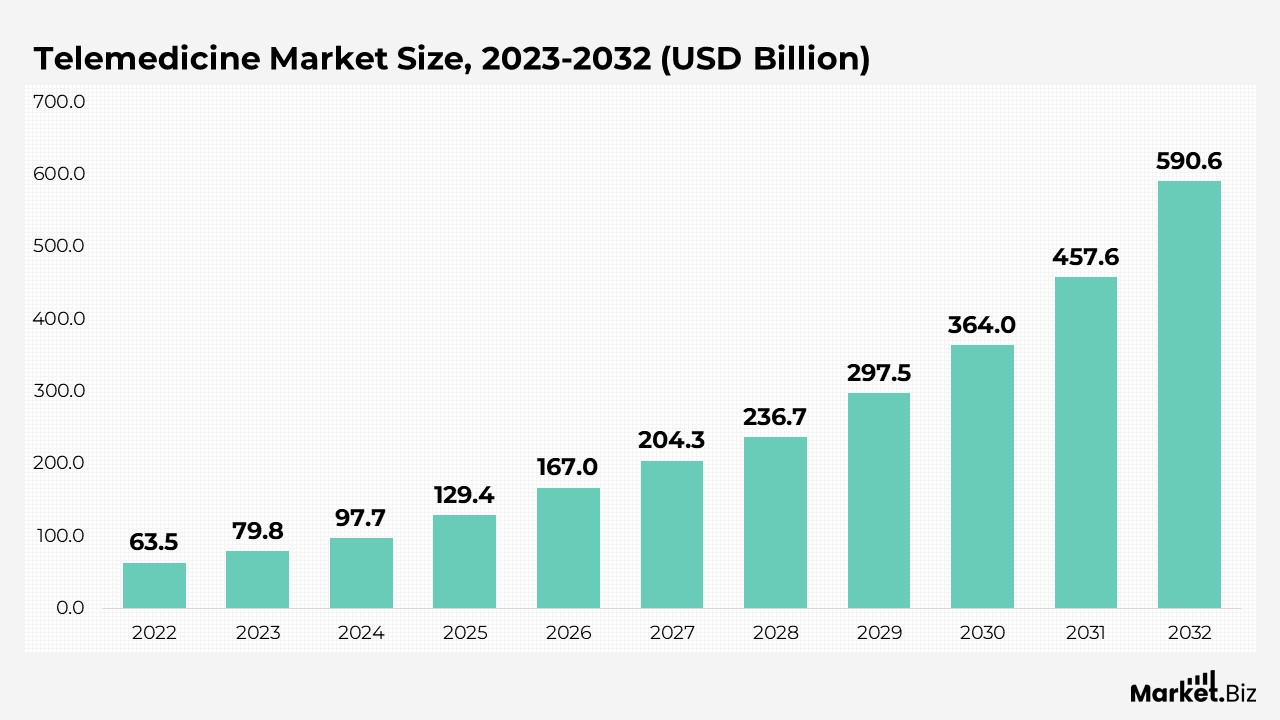
- The global telemedicine market is projected to grow from $129.4 billion in 2025 to $590.6 billion by 2032, with a CAGR of 25.7% from 2023 to 2032.
- Rising healthcare costs, chronic disease burden, technological advancements, and increasing adoption of remote patient monitoring propel market growth.
- The services sector is projected to witness a strong CAGR of over 21% during 2023–2030, while products contributed 45.7% of the market share in 2022.
- Hardware components like medical peripherals and videoconferencing tools led the market in 2021 due to their critical role in enabling virtual consultations.
- The teleradiology segment dominated with a 26.9% revenue share in 2022, driven by growing standardization and regulatory support in radiology services.
- Real-time telemedicine emerged as the leading model owing to the surge in mHealth applications, video consultations, and real-time healthcare services.
- The web/mobile platforms are set to lead in 2023, capturing over 74.05% of global revenue, fueled by smartphone proliferation and rising mHealth engagement.
- Remote hospital facilities accounted for over 50.5% of the market share in 2021, supported by government initiatives and the increased adoption of digital healthcare solutions.
- The patient segment held over 42% market share in 2022, as telemedicine became a primary tool for routine and urgent healthcare needs.
- North America led the global telemedicine market in 2022 with over 36% share, driven by advanced infrastructure, digitization, and high adoption rates.
(Source: Market.us)
Telehealth Market Size
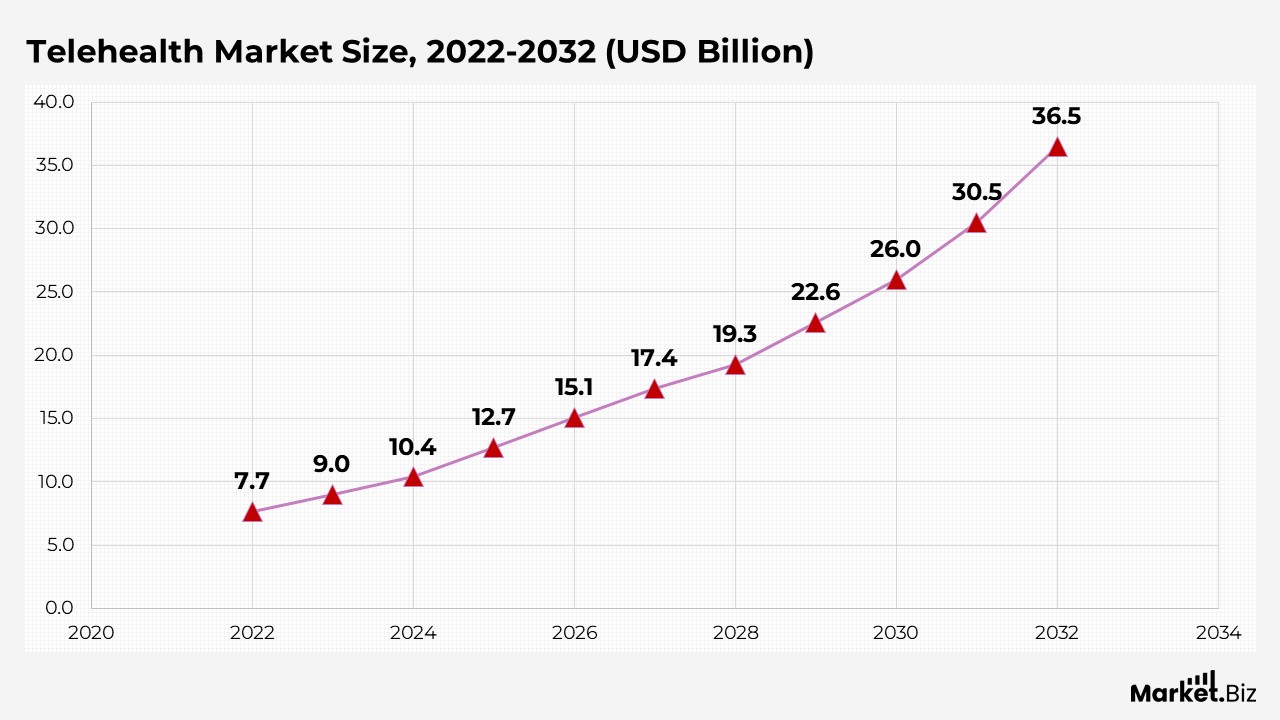
- The global telehealth market is projected to grow from $12.7 billion in 2025 to $36.5 billion by 2032, with a CAGR of 17.3% from 2023 to 2032.
- Telehealth market growth is fueled by rising digital healthcare demand, IT infrastructure upgrades, and increased smartphone and internet penetration.
- The software segment is projected to lead the market, driven by consumer preference for online healthcare access and the rise of wearable medical tech through e-commerce platforms.
- Patient monitoring is expected to be the fastest-growing segment, owing to heightened demand for continuous monitoring, particularly for elderly patients.
- The hospital segment is anticipated to dominate due to the rising need for advanced technologies that enhance operational efficiency and profitability.
- North America captured 47.0% of the global telehealth market share in 2022, supported by strong healthcare IT investment and high digital connectivity.
(Source: Market.us)
Telemedicine Statistics
- Telemedicine has surpassed 80% of global adoption in 2023, with a rising preference for non-video formats like calls and messaging for routine, accessible care.
- Integrating accessibility in telehealth advances inclusive care for 1.3 billion people with disabilities, around 1 in 6 globally, supporting equitable health outcomes.
- In the European Region, telehealth adoption is advancing rapidly, with 84% using teleradiology, 77% offering telemedicine, and 51% providing telepsychiatry services, driven by the use and adoption of telehealth and other digital health solutions.
- The Asia Pacific region witnessed a significant surge in telehealth access, with utilization for primary care and general patient services rising from 4% to 56%, a 52% increase.
- In 2022, 22% of Indian consumers adopted telemedicine for physical health and 33% for mental health support.
- The U.S. and Sweden reported the highest share of 50% and 58% of medical practices offering online services, including prescription refills, test result access, appointments, and visit summaries in 2022.
- A 2022 U.S. poll showed telehealth usage at 38%, down from 48% in 2021 but still above pre-2020 levels. By 2025, over 43% of Americans will use telehealth regularly as a preferred alternative to in-person visits.
- The U.S. has led the advancement of telehealth, particularly in mental healthcare. However, the adoption is now global, with notable uptake among healthcare providers in Scandinavia (70%), Spain (53%), and Denmark (41%).
(Source: World Health Organization, The U.S. Department of Veterans Affairs, The Commonwealth Fund, Willis Towers Watson, Cross River Therapy)
Demographic Trends in Telemedicine Adoption
By Gender
- Women were significantly more likely to use telehealth than men.
- This gender difference continued even after controlling for age, race, location, and clinician speciality.
- Men had 15% lower odds of adopting telehealth for appointments in 2022.
- Patients treated by male clinicians used telehealth less than half as often as those with female clinicians.
- Over three years, women dominated both telehealth user and non-user groups.
- Among non-users, 60% were female and 39% were male.
- In 2022, men accounted for fewer than 4 in 10 total appointments.
(Source: athenahealth, Inc.)
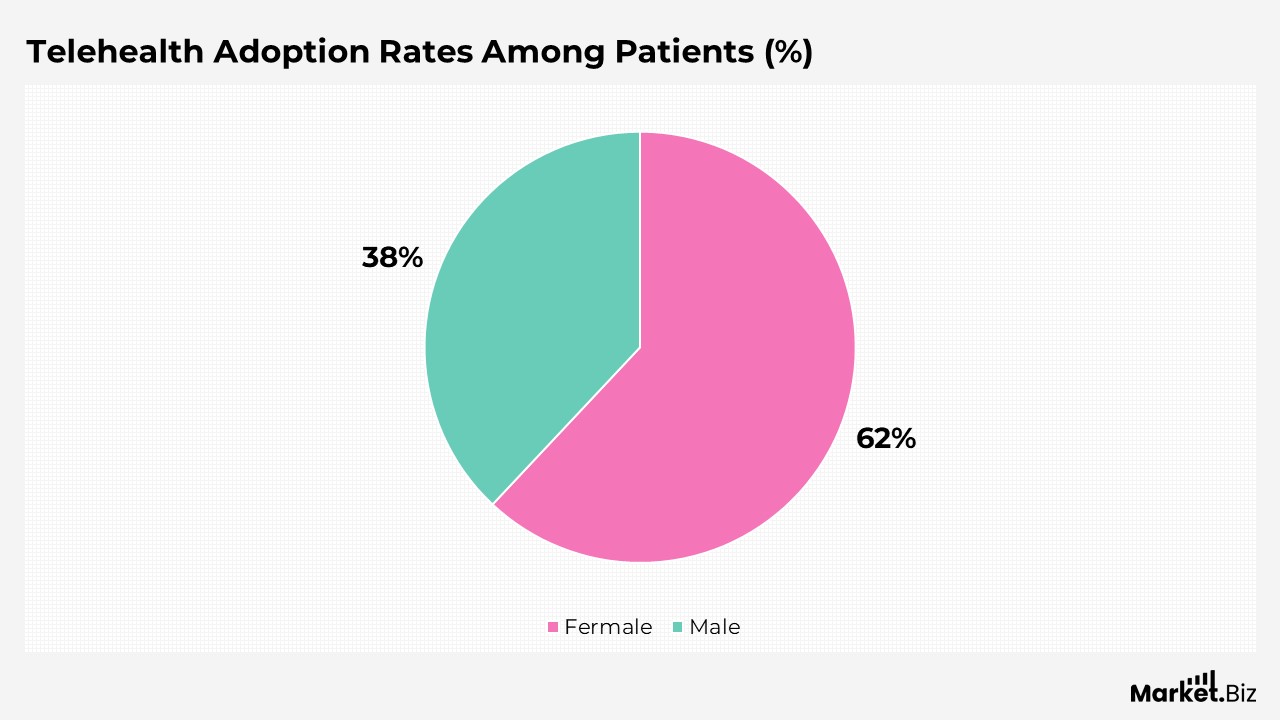
By Age
The medical field is seeing a rise in younger, tech-accepting physicians who are more open to innovative care models like telemedicine. This shift is driving the digital transformation of healthcare and shaping the future of patient care delivery.
- In 2023, doctors under 35 made up 20% of the workforce, signaling a continuous flow of young professionals entering the field.
- The 35 to 44 age group represented the largest share of 30% of physicians, emphasizing a strong foundation of mid-career talent.
- Physicians aged 45 to 54 comprised a substantial share of 20%, reflecting a group with considerable experience at the height of their careers.
- Those aged 55 and above comprised a significant 25% of the medical workforce, pointing to a group approaching retirement or in the later phases of practice.
(Source: Apex ABA Therapy)
Who Uses Telemedicine and Why?
- 80% of consumers have experienced telemedicine at least once.
- Telemedicine usage is high among seniors, with 76% aged 55+ participating.
- Transgender patients exhibit exceptionally high telemedicine utilization at 98%.
- Telemedicine is favored for prescription management 61% and minor health issues 51%.
- Telepsychiatry shows significant patient satisfaction, with 96% reporting positive experiences.
- The U.S. Department of Veterans Affairs has conducted over 2.29 million telemedicine interactions, serving more than 782,000 veterans in 2022 to provide primary and instant care and mental healthcare.
- Telehealth extensively supports medical management 72% and chronic disease care 68%, driven by convenience, efficiency, and ongoing patient engagement.
- Clinicians widely utilize telehealth for therapy 77%, patient screening and diagnosis 72%, follow-up care 70%, continuous monitoring 53%, and triage 41%, aiming for timely, accessible, and coordinated healthcare delivery.
- Nearly 63% of physicians consider telehealth an effective supplement to traditional care, motivated by improved patient access, flexibility, and enhanced clinical outcomes.
- About 85% of physicians adopt telehealth or hybrid care models driven by convenience and enhanced patient access.
- Interactive video consultations 93% dominate telehealth usage, favored for improved patient engagement, while audio-only appointments 69% offer simplicity and broader accessibility.
- More than half, 56% of physicians intend to maintain telehealth integration, motivated by efficiency, patient satisfaction, and continuity of care.
(Source: Rock Health, GlobalMed, PubMed, American Medical Association)
Health Services Delivered via Telemedicine Statistics
Most respondents indicated a willingness to use telehealth services to treat common illnesses and minimize the need for hospital visits.
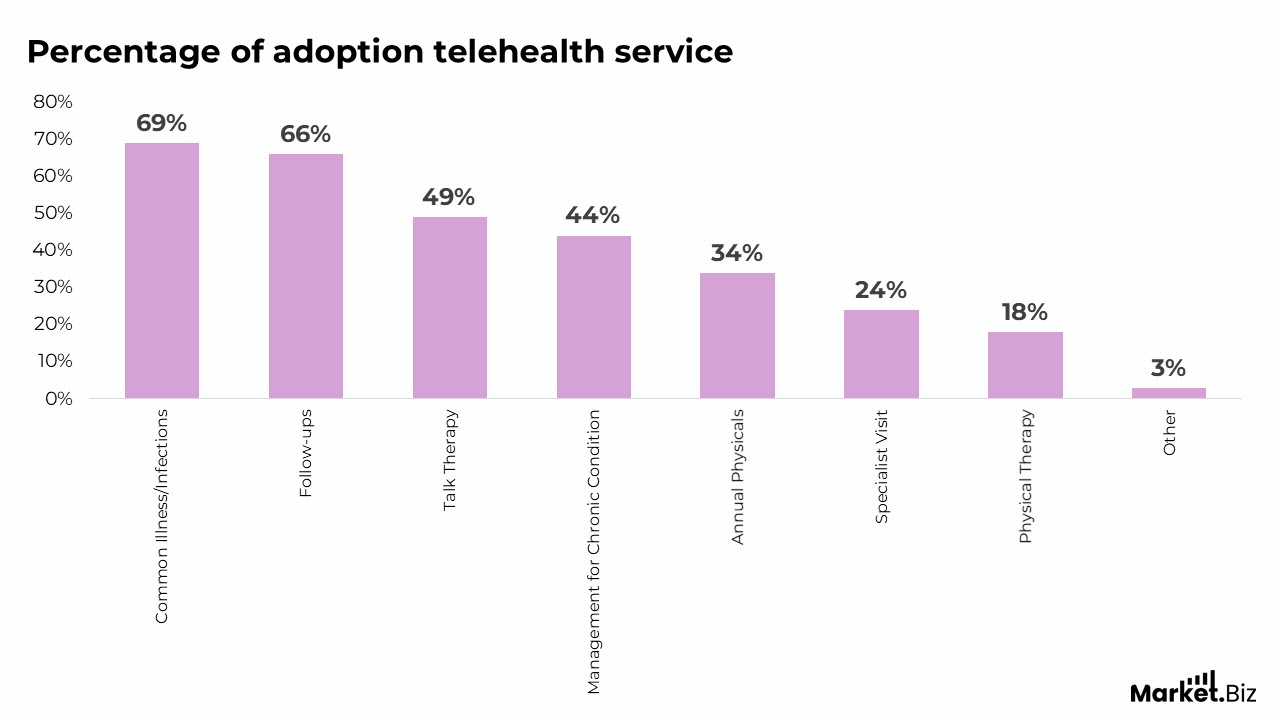
- 69% of patients are open to telemedicine for common illnesses like colds, flu, allergies, and sinus infections.
- 66% prefer virtual follow-up appointments after procedures or hospital stays.
- 49% consider telehealth suitable for talk therapy and mental health support.
- 44% are willing to manage chronic conditions such as diabetes or heart disease via telemedicine.
- 34% are comfortable having their annual physical exams conducted virtually.
- 24% would use telehealth for specialist consultations, including dermatology, OB-GYN, endocrinology, or nutrition.
- 18% see telemedicine as a viable tool for physical therapy sessions.
- 3% would use virtual care for general health inquiries, minor injuries, prescription needs, or refills.
(Source: single care)
U.S. Hospital Participation in Telehealth
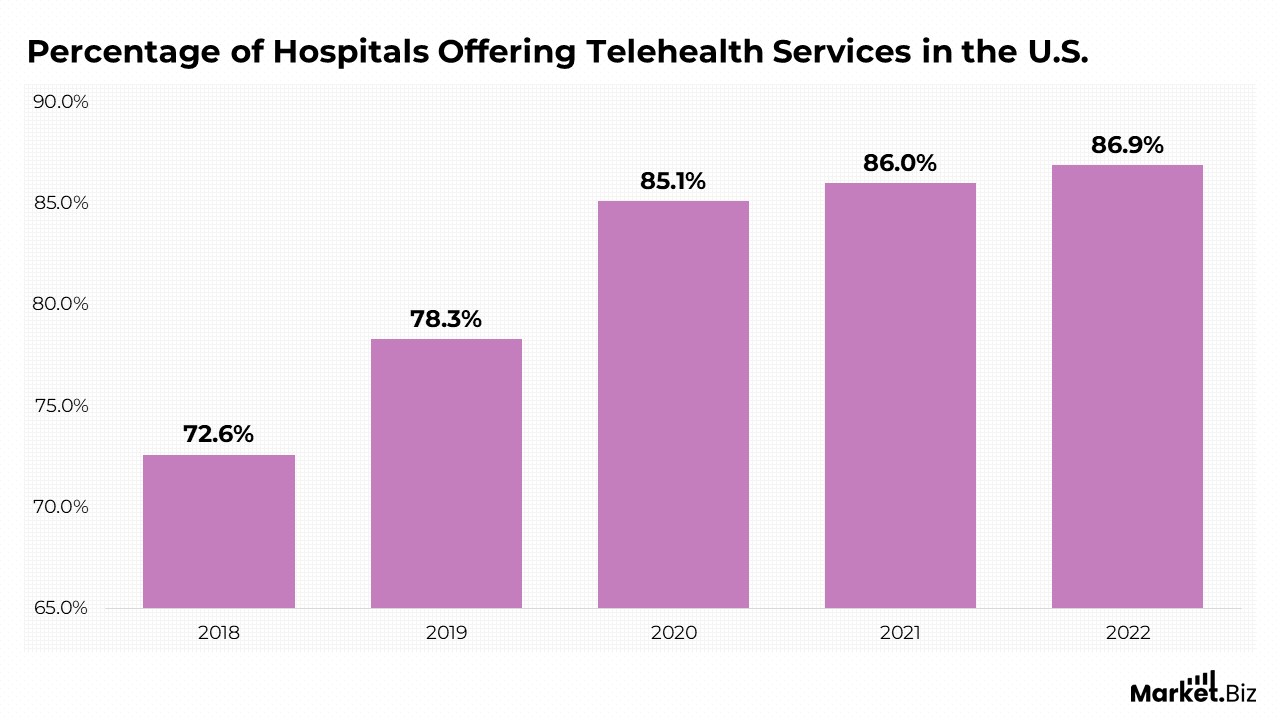
Is the use of telehealth increasing in the U.S.?
Telehealth usage is rising in the U.S., with notable adoption among women 42% and men 31.7%. This trend highlights a growing acceptance of virtual care across different demographics. As telehealth becomes a preferred choice for many patients, healthcare providers can improve patient care by expanding their telehealth services and offering more virtual consultations.
Medicare Coverage of Telehealth
- In 2023, nearly 24% of Medicare fee-for-service beneficiaries accessed care through telehealth.
- Over 20% of adult patients engaged in a telehealth visit as of July 2022, reflecting continued demand for virtual care.
- By 2023, 96% of health centers supported by HRSA had adopted telehealth to deliver primary care services.
- In 2022, more than 4.2 million Medicare patients utilized telehealth services, driven by the increasing adoption of remote care in seniors.
Annual Summary on Telehealth Utilization Under Medicare Part B
| Year | Telehealth Eligible Users | Telehealth Users | Percentage of Medicare Users with a Telehealth Service |
|---|---|---|---|
| 2022 | 28.9 million | 8.5 million | 29% |
| 2023 | 27.9 million | 6.7 million | 24% |
(Source: Assistant Secretary for Planning and Evaluation, U.S. Census Bureau, Household Pulse Surve, Health Resources and Services Administration, Medicare Telehealth Trends Report)
Telemedicine Satisfaction Statistics
- In a survey, 42% of telehealth patients reported being highly satisfied with their experience.
- Another 36% described their virtual care experience as moderately satisfying.
- About 16% of respondents had a neutral opinion regarding their telehealth interactions.
- 4% of participants expressed dissatisfaction with their telehealth experience.
- Just 2% reported being very dissatisfied with the services they received through telehealth.
- Among surveyed healthcare providers, more than 60% found telehealth platforms easy to navigate across urban, rural, and suburban settings.
- Over half of the doctors expressed overall satisfaction with delivering care through telehealth.
- 68% of physicians indicated a desire to increase their use of telemedicine.
- 76% of patients who used telehealth expressed interest in continuing to access care virtually.
(Source: Cross River Therapy)
How much does telehealth cost?
- In a survey, 62% of participants reported paying between $1 and $30 out-of-pocket for each telehealth appointment.
- For 60% of respondents, Medicare fully covered the costs associated with their telehealth visits.
- A study revealed that patients saved between $19 and $121 per visit by avoiding emergency room trips through telehealth.
- Telemedicine equipment led to an 11% reduction in healthcare costs and yielded a $3.30 return for every $1 spent on implementation.
(Source: Cross River Therapy, SingleCare)
What Patients Think About Providers Using Telemedicine
- 58% of respondents confirmed that their healthcare provider currently offers telehealth services.
- 26% were unsure whether telehealth services were available through their provider.
- 16% stated that their provider does not offer any telehealth options.
(Source: SingleCare)
Challenges in Telehealth Adoption
Many consumers are willing to adopt telehealth, though 34% remain hesitant due to various concerns.
- 72% of millennials prefer utilizing health apps to manage their health.
- 51% of consumers report using mobile health apps.
- 25% of seniors have also engaged with health apps.
- Among consumers aged 55-64, 40% and 27% of seniors actively use their health plan’s mobile app.
- 83% of seniors have indicated regular use of blood pressure monitors.
- Additionally, 46% of millennials are incorporating blood pressure monitoring devices into their health routines.
(Source: Amwell Annual Report, HIT Consultant)
Top Telemedicine Platforms
American Well Corporation
- Amwell delivers comprehensive virtual care solutions, including video consultations and remote health monitoring.
- The company reported a total revenue of $254.4 million in 2024.
- Nearly 499,000 users visited Amwell’s website in the past month.
- The platform’s user base is slightly more female, with women making up 54.55% of visitors.
- The most active age group among visitors is 25 to 34 years old.
(Source: Amwell Annual Report, Market.us)
Teladoc Health, Inc.
- Teladoc Health is a global leader in virtual healthcare, offering a wide range of telemedicine services.
- The platform attracts approximately 1.3 million visitors to its website.
- In 2024, Teladoc Health generated a revenue of $ 2569.6 million.
(Source: Teladoc Annual Report, Market.us)
Doctor On Demand
- Doctor on Demand offers virtual healthcare services to patients throughout the United States.
- The platform experienced a 59% surge in visit volumes during the COVID-19 pandemic.
- Urban patient visits peaked at 58% above the pre-pandemic baseline.
- Rural patient visits reached a peak of 64% above baseline levels.
(Source: Fierce Healthcare, Market.us)
MDLIVE, Inc.
- MDLIVE delivers virtual healthcare services nationwide, offering convenient access to medical care across the U.S.
- 78% of patients using MDLIVE’s behavioral health services reported clinical improvement after only three therapy sessions.
- Wellness screenings through MDLIVE’s primary care identified at least one chronic condition in 68% of patients.
- 93% of dermatology patients resolved their condition during their initial consultation with an MDLIVE provider.
(Source: mdlive.com, Market.us)
Recent Developments
New Product Launches
- In November 2024, MedAdvisor Solutions, an Australian company specializing in pharmacy-driven patient engagement solutions, introduced a Telehealth Service on the MedAdvisor Patient App. This new feature enabled patients to consult with healthcare providers and manage their prescriptions from any location or time.
- In January 2022, SwiftMD unveiled its newly designed website, SwiftMD.com, and telehealth app as part of a brand refresh to reinforce its dedication to offering convenient access to quality healthcare.
Acquisitions
- In December 2024, Omda AS, a provider of specialized healthcare and emergency response software, acquired Dermicus AB, a telemedicine company focused on teledermatology and telewound care. This acquisition allows Omda to offer specialized mobile applications and workflows designed to diagnose and manage skin conditions and chronic wounds remotely.
- In May 2024, Avel eCare, a company providing clinician-to-clinician telemedicine services, acquired Horizon Virtual, a U.S.-based provider of virtual hospitalist services. This acquisition strengthens Avel’s leadership in telemedicine by enhancing its ability to support hospitals and health systems nationwide with its acute inpatient model.
Consumer Trends
- Remote patient monitoring devices and wearable health trackers saw significant growth, with sales rising by 35% and 45%, respectively, as more patients turned to proactive healthcare management from the comfort of their homes.
- The growing need for convenient and accessible healthcare has driven the widespread adoption of telemedicine platforms, resulting in a 40% increase in teleconsultation volumes compared to the previous year.
Regulatory Landscape
- Regulatory authorities introduced policies to encourage the adoption of telemedicine, such as reimbursement parity laws and licensure reciprocity agreements. These measures have facilitated cross-border telehealth services, enhancing patient access to
Conclusion
Telemedicine Statistics: Telemedicine has experienced significant growth in recent years, fueled by technological advancements, increasing healthcare needs, and the demand for more accessible medical services.
The data underscores a notable surge in telemedicine adoption, with patients and healthcare providers embracing virtual consultations for greater convenience and better health outcomes.
Key findings indicate telemedicine helps reduce travel time, cut healthcare costs, and boost patient engagement. Its impact on managing chronic conditions and mental health and improving access to healthcare in rural areas has been especially transformative.
However, challenges such as disparities in internet access, digital literacy, and regulatory concerns persist. Nonetheless, telemedicine is primarily transforming the healthcare sector, and data suggests that its adoption will continue to rise in the coming years.
FAQ’s
Telemedicine is a healthcare service that utilizes telecommunication technologies to remotely deliver clinical care to patients. It involves using video calls, mobile applications, messaging systems, and other digital tools to allow healthcare providers to conduct consultations, offer diagnoses, administer treatments, and monitor patients from a distance.
North America currently holds the leading position in the global telemedicine market.
In 2022, the global telemedicine market was valued at approximately USD 63.5 billion, and it is projected to grow to USD 364.0 billion by 2030, reflecting a compound annual growth rate (CAGR) of 25.7%.
